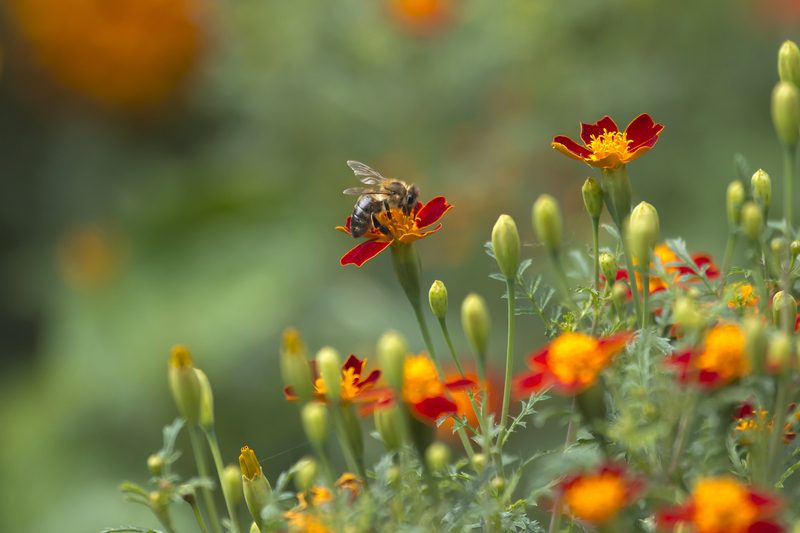Vertical gardening: an upward trend in green living
Posted on 18/08/2025
Vertical Gardening: An Upward Trend in Green Living
Vertical gardening has swiftly climbed the ranks as one of the most exciting and innovative trends in the world of green living. From urban balconies to spacious interiors, people are reimagining traditional gardening models to fit modern lifestyles. This practice not only maximizes limited space but also delivers a host of environmental, aesthetic, and health benefits. If you're curious about adopting this sustainable gardening method, this comprehensive guide will walk you through everything you need to know about vertical gardens, alternative names like living walls and green walls, and how they're revolutionizing spaces across the globe.
What is Vertical Gardening?
Vertical gardening is the art and science of growing plants upwards rather than outwards, employing vertical surfaces like walls, trellises, or modular panels. It's an innovative gardening technique that transforms unused vertical spaces into lush, vibrant habitats, making it possible to cultivate a variety of plants even in the most compact areas.
- Living walls or green walls are popular forms of vertical gardens often seen in urban architecture.
- This method is ideal for small apartments, balconies, office buildings, and even large-scale landscaping projects.
Why Vertical Gardening is Gaining Popularity
The movement towards vertical gardening is not merely an aesthetic choice—it solves real-world problems caused by shrinking living spaces and environmental challenges.
- Urbanization: With the steady increase in urban living, space has become a precious commodity. Vertical gardens allow people to grow their own food and beautify their environment without requiring traditional horizontal garden plots.
- Sustainability: These gardens encourage eco-friendly practices, such as composting and organic farming in small spaces, bolstering the drive for greener cities.
- Innovation: Advancements in gardening technology have made vertical gardens more accessible, with modular systems and smart irrigation.

Main Benefits of Vertical Gardening
Embracing a vertical approach to gardening offers numerous benefits for individuals, communities, and the planet.
1. Maximizing Limited Space
In city centers or apartments where square footage is limited, vertical gardening is a game changer. Using walls or vertical frames, even those living in micro-apartments can cultivate herbs, flowers, and small vegetables.
2. Improved Air Quality
Green walls help purify the air by absorbing toxins and releasing oxygen. This enhances indoor and outdoor environments, making them healthier and more pleasant for inhabitants.
3. Thermal Insulation and Energy Efficiency
Vertical gardens act as natural insulators, regulating building temperatures. This can reduce the reliance on air conditioning in the summer and heating in winter, leading to significant energy savings.
4. Enhanced Mental Well-being
Research consistently demonstrates that proximity to greenery reduces stress and improves mood. Vertical gardens bring nature closer, fostering well-being in homes and workspaces.
5. Increased Biodiversity
Encouraging a diversity of plant life contributes to the creation of microhabitats for birds, insects, and pollinators in urban settings.
6. Aesthetically Pleasing Spaces
Living walls and vertical plant installations can transform bland surfaces into stunning, living artworks, enhancing both residential and commercial spaces.
Types of Vertical Gardening Systems
The world of vertical gardening is filled with different systems designed to suit various needs, budgets, and levels of expertise. Here are some of the most popular options:
1. Trellises and Lattices
A classic choice, trellises provide support for climbing plants like peas, beans, and flowering vines, making them an excellent introduction to upright gardening.
2. Modular Panel Systems
These pre-fabricated structures are designed for easy installation. Panels contain slots or pockets for individual plants, allowing for creative arrangements and rapid changes.
3. Pocket Planters
Made from felt, fabric, or recycled materials, pocket planters allow you to install rows of plants on vertical surfaces, adding texture and color to walls indoors and outdoors.
4. Hydroponic and Aeroponic Green Walls
These soil-free vertical gardens use nutrient-rich water or mist to nourish plants, offering efficient, mess-free solutions, especially for high-tech environments.
5. DIY Pallet Gardens
Repurposing wooden pallets as vertical garden frames is a popular, budget-friendly method for urban dwellers and beginners alike.
Best Plants for Vertical Gardens
The success of a vertical garden relies heavily on plant selection. While almost any plant can be trained to grow vertically, some species are particularly well-suited to this system.
- Herbs: Basil, mint, parsley, thyme, cilantro, and oregano are compact, thrive easily, and provide a fresh source of culinary flavor.
- Leafy Greens: Lettuce, spinach, Swiss chard, and kale adapt well to vertical setups and offer rapid yields.
- Vining Vegetables: Peas, beans, cucumbers, and small squash varieties naturally climb and make excellent use of trellises and lattices.
- Strawberries: Their shallow root system and cascading habit make them ideal for living walls or pocket planters.
- Ornamentals: Ferns, succulents, ivies, pothos, philodendron, and flowering annuals like petunias or nasturtiums create lush, visually appealing displays.
Step-by-Step Guide: Building Your Own Vertical Garden
Ready to embrace vertical planting at home? Follow this step-by-step guide:
1. Choose Your Location
- Assess the amount of sunlight the intended vertical surface receives.
- Both indoor and outdoor walls can work—choose based on your goals and space constraints.
2. Select a Vertical System
- Decide between trellis, panels, pocket planters, or a DIY option based on your available space and budget.
3. Choose the Right Plants
- Pick species according to light, temperature, and maintenance needs.
- Mix edibles and ornamentals for aesthetics and function.
4. Prepare the Structure
- Install your chosen system securely against the wall or vertical frame.
- If using soil, ensure appropriate drainage and irrigation setup.
5. Plant and Maintain
- Plant seedlings or young plants in designated pockets or troughs.
- Regularly water, fertilize, and prune as needed for healthy, vibrant growth.
Vertical Gardening in Urban Spaces
Modern cities are cramped, but wall gardening offers a bright solution. Many urbanites have turned to balconies or rooftops, using creative upward gardening methods to foster green sanctuaries amid concrete jungles. Some notable vertical gardens include:
- The Musee du Quai Branly in Paris: One of the most prominent examples of a living wall, showcasing hundreds of plant species and redefining building aesthetics.
- The CaixaForum in Madrid: Home to a striking vertical garden over 78 feet tall, transforming dull city blocks into vibrant points of interest.
- Singapore's Changi Airport: Features an exceptional collection of vertical gardens and green walls that offer both beauty and tranquility to travelers.
The Environmental Impact of Vertical Gardening
The sustainability benefits of vertical gardens go far beyond personal fulfillment and attractive decor. They have significant positive effects on the wider environment:
- Reduction in Urban Heat Islands: Green walls help cool buildings and surrounding areas, mitigating climate change impacts at city level.
- Stormwater Management: Plants absorb rainwater, reducing runoff and decreasing flooding risks.
- Enhanced Biodiversity: These gardens become micro-ecosystems within cities, attracting pollinators and birds.
- Air Filtration: Plants trap dust, pollutants, and carbon dioxide, resulting in cleaner air for all residents.
By leveraging previously underutilized surfaces, vertical planting systems are not just saving space—they are actively healing urban environments.
Challenges and Considerations
While vertical gardening offers many upsides, it's important to recognize and plan for potential challenges:
- Watering and Irrigation: Upright gardens often require specialized irrigation systems to ensure even moisture distribution. Automated drip or misting systems help, but setup and ongoing maintenance are required.
- Structural Load: Walls and frames must be robust enough to support the weight of plants, soil, and water. Consultation with specialists is essential for large installations.
- Plant Health: Vertical gardens can be more susceptible to pests and diseases due to high plant density. Regular monitoring and proper care routines prevent major problems.
- Light Requirements: Not all spaces receive enough light for all plant species. Selecting shade-tolerant plants or installing grow lights can optimize results.
- Cost: While small DIY projects are affordable, larger, professionally-installed living walls can be a significant investment. Benefits often outweigh upfront costs over the long term.

Sustainability, Innovation, and the Future of Vertical Gardens
The surge in vertical gardening demonstrates an exciting intersection of environmental stewardship, technology, and design. As populations rise and cities expand, the need for innovative ways to integrate nature into our daily lives becomes crucial. Upward planting systems, from small balcony installations to grand architectural features, symbolize a paradigm shift towards more mindful, sustainable urban living.
Innovations like hydroponic walls, automated care systems, and modular living wall kits make green spaces even more accessible to everyday people and businesses. City planners, architects, and homeowners are now collaborating to bring green living front and center.
Conclusion: Embrace the Benefits of Vertical Gardening
Vertical gardening is more than just an aesthetic trend—it's a practical, eco-friendly solution to some of the most pressing challenges of modern living. By utilizing vertical space, anyone can cultivate lush gardens, enhance their mental well-being, reduce their environmental footprint, and contribute to healthier, more beautiful communities.
Whether you're an apartment dweller, a homeowner, or a commercial property manager, there's a vertical planting solution tailored to your needs. Embrace this upward trend in green living, and transform your walls into thriving, living landscapes.
Start your journey today and join the movement towards a greener, more sustainable future with vertical gardening!



